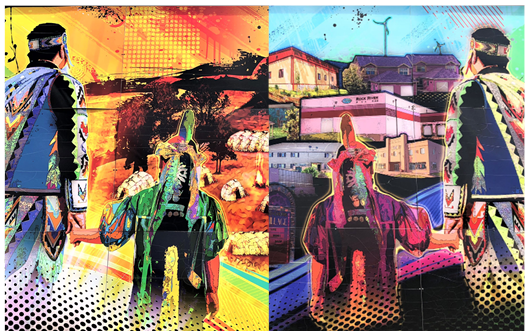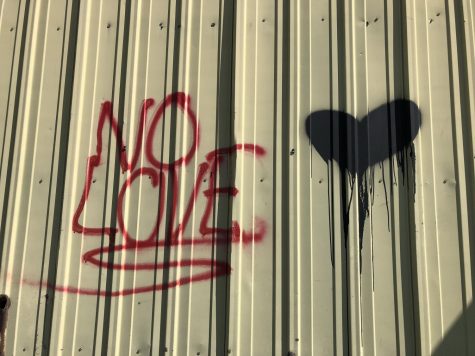Nebraska tribes must be proactive to better themselves

These two murals are on the side of a Dollar General, a joint tribe and corporate owned facility. They depict the changes in clothing and way of life that the tribe has faced since its move to Nebraska. Photo by Corey Griffin
November 1, 2018
The United States is responsible for its crime against humanity, the near complete destruction of an entire culture, and yet it continues to deny that such an atrocious event even occurred. The systematic killing, relocating and purging of Native Americans began at the very foundation of this country, and continues today.
“Within no more than a handful of generations following their first encounters with Europeans, the vast majority of the Western Hemisphere’s native peoples had been exterminated,” David E. Stannard, renowned historian on Native American culture and history, wrote in his book American Holocaust. “The European habit of indiscriminately killing women and children when engaged in hostilities with the natives of the Americas was more than an atrocity. It was flatly and intentionally genocidal.”
And a genocide it was.
The Umónhon tribe (also known as the Omaha tribe) migrated from the Ohio River valley to the Missouri River valley upon European settlement and was a prominent stop on the Lewis and Clark expedition. Epidemics and Sioux invasions forced the tribe to move several times, the tribe reluctantly agreed to an offer by the US government to settle on land in present day Thurston County. White settlers nearly eliminated buffalo and other game necessary for their survival and governmental policies designed to destroy traditional culture caused the tribe to suffer.
The Ho-Chunk tribe (also known as the Winnebago tribe) was one of the largest and most dominant tribes of the Green Bay region of present-day Wisconsin, but the United States federal government moved the tribe 13 times through Iowa and South Dakota. Because of these moves and several introduced diseases, their population dropped from around 5,000 to a few hundred.
The Umónhon and Ho-Chunk tribes agreed to split Thurston county so that both tribes could live on the land, only 11 miles from each other, and after decades of abusive policies from the state and federal governments the tribes were forced to assimilate to western styles of clothing, construction, and language as they were forced to speak English. The tribes were short on money, and the people were suffering shortages of necessities including food.
The Umónhon and Ho-Chunk are extremely similar up to this point. Their towns were impoverished, houses and businesses were unsafe, and they were reeling from mistreatment from the American government and people.
In 1988, the tables began to turn when the Indian Gaming Regulatory Act kept tribal sovereignty to build casino halls, and subsequently both tribes began construction of casinos. The CasinOmaha and the WinnaVegas casinos opened in 1992, and in 2011 the CasinOmaha was renamed the Blackbird Bend Casino.
The difference is how the tribes invested the money, the profit earned from the Omaha casino goes to the tribal council, where the money is then distributed among the people. The profit earned from the Winnebago casino goes to the tribal council, which then invests it in community infrastructure.
When people receive checks, they tend to spend it all at once and don’t have the will to work for their money. Even though they receive the benefits from the casino, Macy, the largest town on the reservation, remains one of the poorest in the state, with 49% of the people under the poverty line.
The Ho-Chunk tribe has used the funds to build community facilities, including a new hospital, community center, and parks. Investment has also gone into Ho-Chunk, Inc. which is a global economic development agency, and the largest employer of the tribe. Construction is booming across the city of Winnebago, and the tribe is experiencing a time of wealth.
The cities of Macy and Winnebago are only 11 miles apart but look completely different, Winnebago is a pinnacle of newfound prosperity and Macy is struggling to survive.
While Macy is beginning a cultural and educational revival after federal funds allowed for the construction of a new school, the tribe’s method of monetary management is pushing their people and their culture backward.
Meanwhile, the Ho-Chunk is an example of a positive reaction to the events that took place in the previous centuries, utilizing the money that they earn from the casino to invest in themselves and their culture. Already, the Ho-Chunk tribe is building new cultural centers, reigniting old traditions, and creating apps and education programs to relearn their language.
Tribes like the Ho-Chunk are the exception, rather than the rule. The Ponca tribe, famous for Chief Standing Bear’s trial at Fort Omaha, was relocated to Oklahoma and faces similar problems to that of the Umónhon. The Ho-Chunk needs to begin further outreach to tribes like the Ponca and Umónhon so that their prosperity is not an isolated case. Only then can the effects of the United States government begin to heal.
Although the US government holds responsibility because of its actions to these people in the past, tribes need to be proactive and step their own feet forward because the current system is too slow and lacks public support. Tribes need to follow the example of the Ho-Chunk, and begin to create their own future as a community.

Photo by Corey Griffin


